- Site Author and Publisher Richard Jones
- Richard Jones
THE FORMER MORTUARY - ST GEORGE-IN-THE-EAST
| Location: St. George-in-the-East, Shadwell, London, E1 0BH |
A STUNNING CHURCH AND A PEACEFUL CHURCHYARD
The church of St George-in-the-East is, quite simply, stunning.
It was built between 1714 and 1729, to the design of Nicholas Hawksmoor, and the tower is such a striking local landmark that Nikolaus Pevsner (1902 - 1983), in his East End edition of his guide to The Buildings of England, was moved to describe it as "...the most original of Hawksmoor's East End churches..."
Its churchyard provides a lovely, quiet retreat from the ceaseless roar of The Highway, which passes to the south of the church.
Eastenders have been taking the air at this halcyon spot since the late 19th century. Indeed, the churchyard holds the distinction of being one of the first London burial grounds to be transformed into a public park, and was opened as a municipal garden in January, 1877.
But the tranquil little garden also holds a dark - some might even go so far as to say "macabre" - secret.
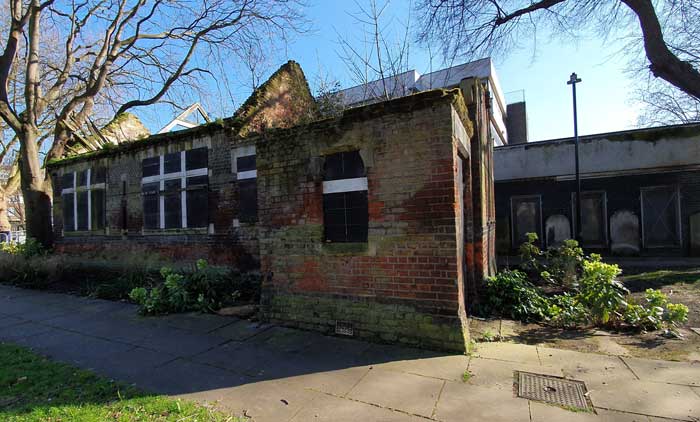
THE FORMER MORTUARY BUILDING
For, squatting close to the asphalt path that meanders its way through the churchyard, you will find a tumbledown brick shed.
The roof of this curious little building has long since fallen in, and skeletal rafters poke skywards from what remains of it. Ominous black shutters have been affixed to its crumbling outer walls in order to keep the public out. Nothing though can keep nature at bay, and weeds and saplings sprout from what passes for a roof; whilst, even on a bright summer's day, a feeling of chilly melancholy seems to permeate the air around the ruin.
It is safe to say that few of those who sit in, stroll or jog through, exercise in, or - in the case of the adjacent children's play area - play in the garden bother to pay the tottering ruin any real attention.
I would hazard a guess that none of them - well, alright then, maybe a few of them - are aware of the building's association with the Whitechapel murders of 1888 - 1891.
And, who could blame them? For there is nothing here to suggest that there is any connection with the notorious Victorian crime spree.
Even the adjacent information board, which provides, for those curious enough to read it, a brief synopsis of the building's history, is mute about its Jack the ripper connection, simply stating that it was originally a mortuary that, "was converted to a Nature Study Museum in 1904 and opened to the public as a branch of the Whitechapel Museum..."
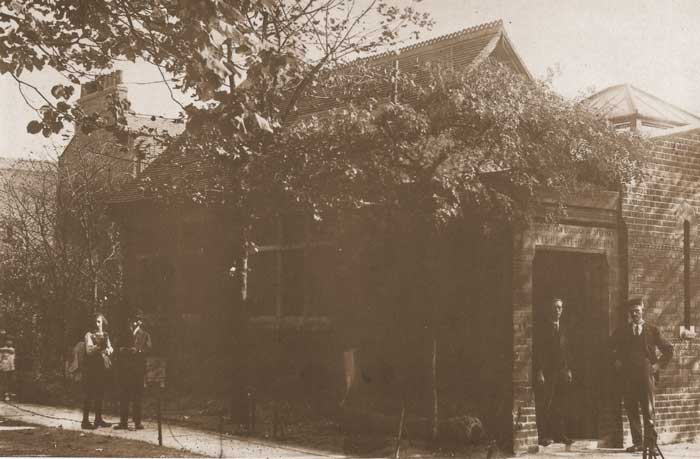
ITS CONNECTION TO THE MURDERS
It was during its period as a mortuary that it acquired its connection with the Whitechapel murders.
For this was the mortuary to which the bodies of two of the victims - those of Elizabeth Stride and the Pinchin Street Torso were brought in the immediate aftermath of their deaths.
And, as such, it is one of only a handful of buildings to have survived in the district that have a direct connection with the case.
THE LACK OF ADEQUATE MORTUARY FACILITIES
One of the observations made at the inquests into the deaths of several of the victims - and in many other inquests of the era for that matter - was that Whitechapel lacked any proper mortuary facilities for the storage of bodies and the carrying out of post mortems when the need arose.
At the inquest into the death of Mary Nichols, which was held at the Working Lads Institute, the Coroner Wynne Edwin Baxter, commenced his summing up by "commenting strongly on the absence of a public mortuary in Whitechapel, where it was so greatly required. "
The jury agreed with him, and, having returned their verdict, they added a rider "expressing the full concurrence of the jury with the coroner's remarks as to the need of a mortuary for Whitechapel."
A MORTUARY FOR ST. GEORGE-IN-THE-EAST
However, the debate over adequate mortuary facilities in the district was not a new one. Indeed, the issue had been discussed by the Parish Vestry of St. George-in-the-East as far back as July, 1867; as is evidenced by the following report on the meeting, which appeared in The East London Observer on Saturday, 13th July, 1867:-
THE MORTUARY HOUSE
This question then came before the Board for consideration.
Mr. Outhwaite said he did not know how other parishes might be situated, but he believed there was dead-house in Aldgate. No doubt the Medical Officer had a good reason for requiring mortuary houses.
The Medical Officer said doubt the members of the Board would recollect that last quarter there were three cases in the district of the body being left in the house for an unreasonable period. In one case it remained as long as twenty-one days, and it could not be removed, because there was no place to remove it to. There was a case the other day where a body was left lying in a room that was occupied by seven people, each person having only 219 cubic feet of air, and there the body remained until it became a perfect nuisance to the place.
The Chairman: "If you had a mortuary house could you remove it?"
The Medical Officer: "Oh yes, because we could compel the people to let us move it immediately. The Act of Parliament prescribes that we must have a place where post mortem examinations can be performed separate from the mortuary, and, this for various reasons. The poor had a horror of an examination being made. He hoped the Board would pass a resolution that they should have one or two."
Mr. Sparkes would like to know whether the Board could not agree with some other parish, and have one in the cemetery. There was a deadhouse in Aldgate, but he had no doubt that the inhabitants would object to a bad case being taken there.
Mr. Ilsley: It is suggested to have them in the churchyards. That is not so objectionable as the dead-house in Aldgate. He thought it would be very inconvenient to remove a body some miles from the place where it died, because, in the event of an inquest having to be held, the jury would have to go the distance, and then return.
Mr. Outhwaite was glad that the Medical Officer had explained why the mortuary houses were necessary. It was an evil that bodies should remain for so long a time in the crowded parts of London.
After some further conversation on the place to be appointed for post-mortem examinations, the Clerk stated they must have a separate building for this from the mortuary.
The Chairman thought it was necessary that a mortuary house should be erected, for the statement made by the Medical Office revealed a shocking state of things.
The Board was not about to decide on the erection of the buildings, but simply passing a resolution to the effect they were necessary.
The motion was then carried and the matter referred to the Committee of Works."
The East London Observer: Saturday, 13th July 1867.
THE MORTUARY IS BUILT
Although no exact year of construction can be ascertained, it would appear that the mortuary had been erected in the churchyard by 1869, when conditions inside it were severely criticised by a local doctor who had carried out a post mortem there into the death of a murder victim:-
Mr. Budgett, the surgeon, who was called to give the results of a post mortem examination of the body, made some extraordinary statements.
He said that, in the interests of justice, he desired to state that he could not make a proper scientific examination of the body with the appliances placed at his command.
He had had to make the examination in a small house at the end of St. George's Churchyard.
In that house there was no table, no light, no chair, no towel.
To let in the light, he had to open the door and bring the body of the deceased to it. He had to place the body on a bench made of coffins, and then, placing the deceased on a coffin lid, he was able to make an examination of his body.
In order to proceed with his examination he felt obliged to take his coat off, and, whilst he was busy, a crowd of people collected in the churchyard and looked at him and at the dead man's body.
When he had taken the stomach out of the body, he found it was necessary for him to carry it into the churchyard, in order that he might examine it sufficiently.
The workhouse people thought it quite sufficient to send him an old pauper to carry water for him, and the water he had was carried in a bucket.
There was no soap in the house, but the old pauper was able to produce a piece "for a consideration."
The witness thought that it was his duty in the interests of justice that he should make this statement."
The East London Observer: Saturday, 17th April 1869.
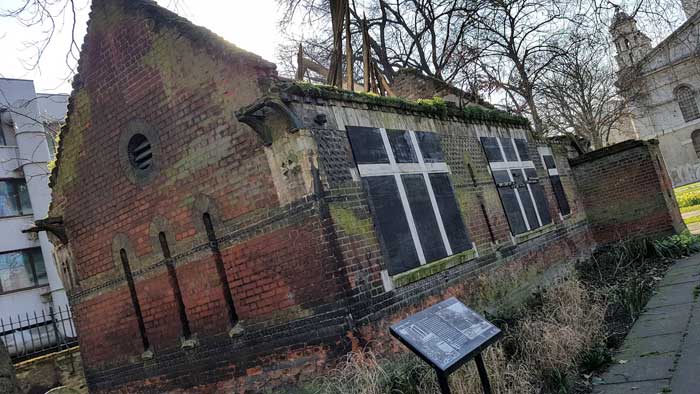
THE VESTRY RESPONDS
Evidently stung by this public criticism, the Parish Vestry discussed the case at its meeting, held on the 16th of April, 1869:-
At the meeting of the St. George's-in-the-East, Vestry, on the 16th inst., Dr. Rygate, the medical officer, referred to the report which had appeared in the morning paper of the 13th inst., to the defective accommodation at the dead house of the parish.
In the report it was stated that Dr. Budgett, the medical man who made the post-mortem examination in the above case, gave evidence at the inquest to the effect that in the dead house there was neither table nor chair; and that so open was the place to the public gaze, that a mob collected to witness his proceedings, and, owing to the want of light, he was compelled to take the stomach out into the churchyard to examine it.
Also, that there was neither towel, water, nor soap in the dead house, and that the doctor only obtained the latter by giving the pauper attendant pecuniary consideration.
The medical officer said that he had visited the dead house that day and found that the charcoal bench provided by the vestry had been removed, and he recommended that this should be replaced and water laid on.
He could see perfectly well in every part of the building, which was, moreover, quite free from being overlooked, being 180 yards from the back of the rectory.
In the conversation which ensued, it was stated by various members that the mob alluded to consisted of only three persons; that soap and towels were always kept on the premises, and that the pecuniary consideration to the pauper was not for providing any of these articles, but for sewing up the body. The attendant also declared that the stomach was never removed from the body at all, and could not have been taken into the churchyard by Dr. Budgett. It was also stated that the dead house was altered during the cholera year at the instance of the Government inspector, and every request of his complied with.
Mr. Herbert complained that a post mortem examination in the case was wholly unnecessary, there being ample evidence of the man having been brutally murdered by being thrown on the pavement and jumped upon in the presence of three or four witnesses, and some strong observations were made as to the overdrawn and false character of the statements which had been made."
The South London Chronicle: Saturday, 24th April 1869.
ELIZABETH STRIDE'S BODY BROUGHT HERE
Since the murder of Elizabeth Stride, on the 30th of September, 1888, took place in Berner Street, just a few streets north of the churchyard, this was the nearest mortuary to the scene of the crime, and so the body was brought here.
Looking at the structure today, you sense that it really must have been cramped inside, and the task of carrying out the post mortem on the body cannot have been a pleasant one for Dr, George Bagster Phillips who performed it.
Some idea of how onerous the task must have been can be gleaned from the following illustration, which appeared in the Penny Illustrated Paper on the 6th October, 1888.
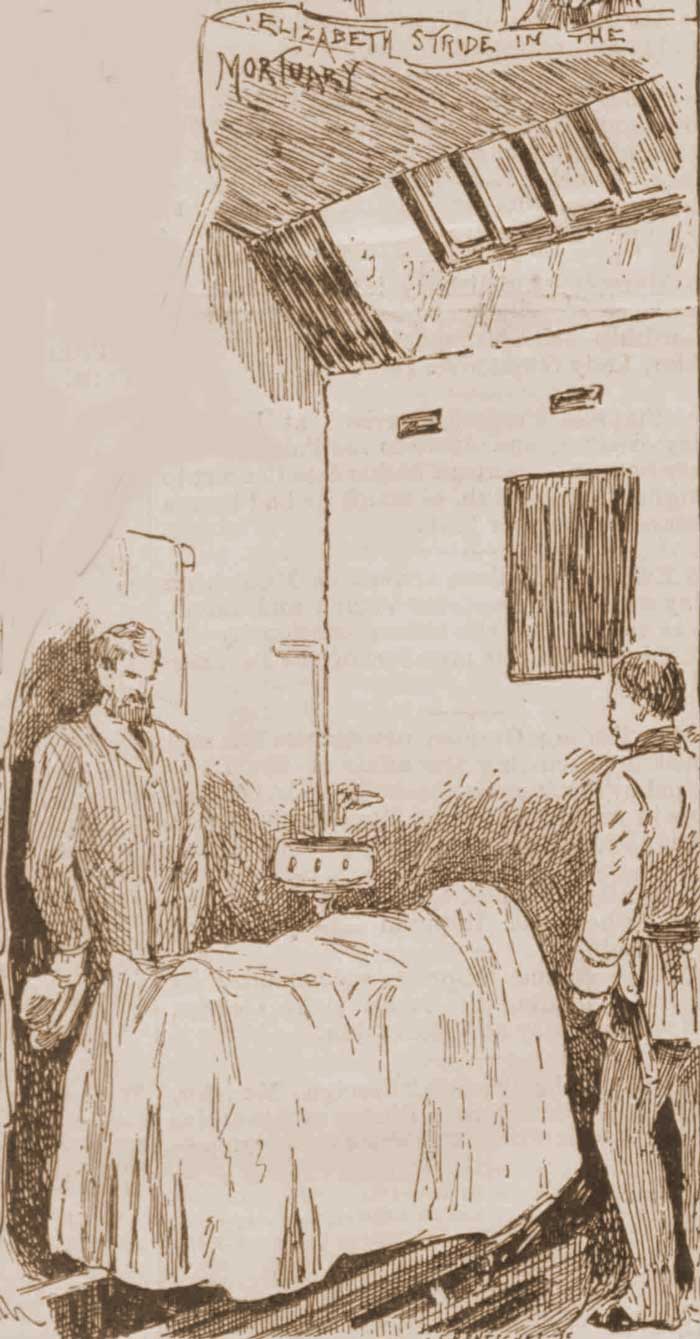
THE JURY VIEW THE BODY
It must have been even more claustrophobic when, on the opening day of the inquest into Elizabeth Stride's death, which took place in the Vestry Hall which still abuts onto the churchyard, the coroner and the jury trooped round to the mortuary to file in and view the body.
The following report, which appeared in the Christchurch Times on Saturday, 6th October, 1888, captured the gruesomeness of the scene that they encountered:-
Mr. Wynne E. Baxter, the coroner for the district, opened an inquest at the Vestry-hall, Cable-street, St. George's-in-the-East, on the body of the unfortunate woman mysteriously murdered in a yard at the rear of a club in Berner-street, Commercial-road.
The jury having been sworn, proceeded to view the body, which lay in the mortuary adjoining the Vestry-hall, and the coroner held a consultation with Dr. Phillips and other medical men engaged in the case.
After looking upon the horrible spectacle of the dead woman, still fully dressed in the clothes she wore, with her throat cut and bloodstained face, the jury returned to the Vestry-hall, where some evidence was taken..."
The Christchurch Times: Saturday, 6th October, 1888.
MARY MALCOLM
Various witnesses also came to the mortuary to view the body, as efforts were made to identify the victim in the immediate aftermath of her murder, amongst them Mary Malcolm, who claimed that the victim was her sister, Elizabeth Watts.
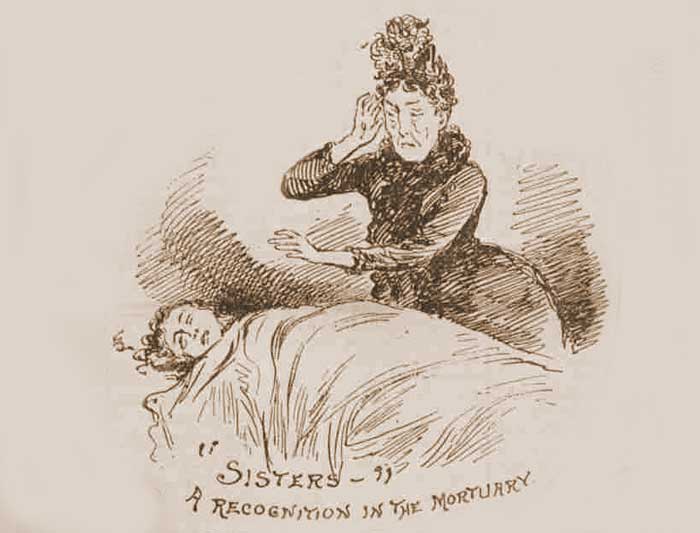
OTHER WITNESSES
It was also reported by some newspapers that, "a large number of prostitutes were allowed to visit the mortuary with a view to identification."
However, as the Dundee Courier reported, "several of them professed to recognise the deceased, but they were unable to state her name and address."
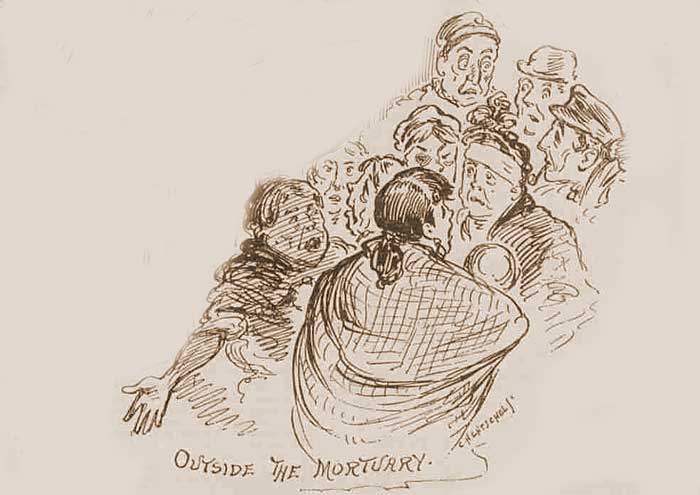
MATTHEW PACKER TURNS UP
One other witness who turned up at the mortuary was Matthew Packer, the fruit-seller from Berner Street, who claimed that, shortly before the time of the murder, he had sold grapes to a man who was accompanied by a woman who resembled the description of the victim.
What is interesting about the following report of his visit, which appeared in The Eastern Daily Press on Saturday, 6th of October, 1888, is that the process for admission to view the body appears to have been quite rigorous:-
TRUE STORY OF THE FRUITERER
Matthew Packer, the owner of the little fruit shop in Berner street...visited the mortuary of St. George's in the East, accompanied by two private detectives, for the purpose of seeing whether he could identify the body of Lizzie Stride as that of the woman for whom the grapes were purchased on the night the murder.
At the entrance to the mortuary, the official in charge subjected Packer to a severe cross examination in reference to his knowledge in the matter.
He described correctly the clothes the woman wore, and was led inside where he had no difficulty identifying the body as that of the woman for whom the grapes were bought."
The Eastern Daily Press: Saturday, 6th October, 1888.
THE PINCHIN STREET TORSO
Eleven months later, on Tuesday, 10th September, 1889, the headless torso of an unidentified woman was found beneath a railway arch in Pinchin Street, a few streets south of the Elizabeth Stride murder site in Berner Street.
As had happened with Liz Stride, the remains were taken to the St George mortuary, where crowds once again gathered to try to gain admission and view the torso.
The Aberdeen Press and Journal, reported on the scene around the mortuary in its edition of Wednesday, 11th September, 1889:-
REMOVAL OF THE BODY
The body of the deceased was removed to St George's Mortuary, and a large crowd gathered there directly, remaining throughout the whole day.
Many unfortunates called to see the trunk, but none could identify it.
In fact, there are no marks whatsoever on the remains which would enable anyone to conclusively identify the body, and unless some other portions are discovered, it is quite possible that the matter will ever remain a mystery.
The police have no present knowledge of any one missing corresponding with the deceased."
The Aberdeen Press and Journal: Wednesday, 11th September, 1889.
IT BECOMES A MUSEUM
In 1904, the building was converted for use as a Nature Study Museum in what, as the information board outside puts it:-
...was a pioneering effort in an overcrowded inner city area to give local people the opportunity to have more contact with nature."
You can still make out the sign for the museum above the former entrance.
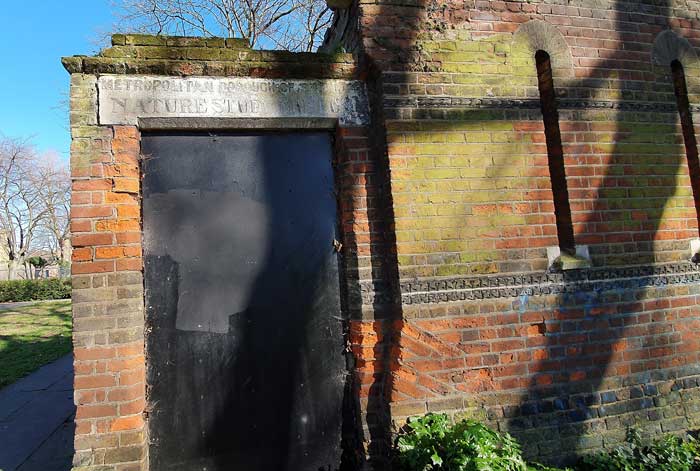
EVEN MORE CROWDED
You can't help thinking, as you look at the tiny structure, how even more crowded it must have been as a museum than it was as a mortuary, especially when you consider that, according to the information board:-
During the summer months, up to 1,000 people a day reputedly visited the Museum, mostly groups of local school children.
The exhibits included tanks of live fish and amphibians, stuffed birds and mammals and displays of butterflies..."
The question that inevitably springs to mind is, where on earth did they put it all?
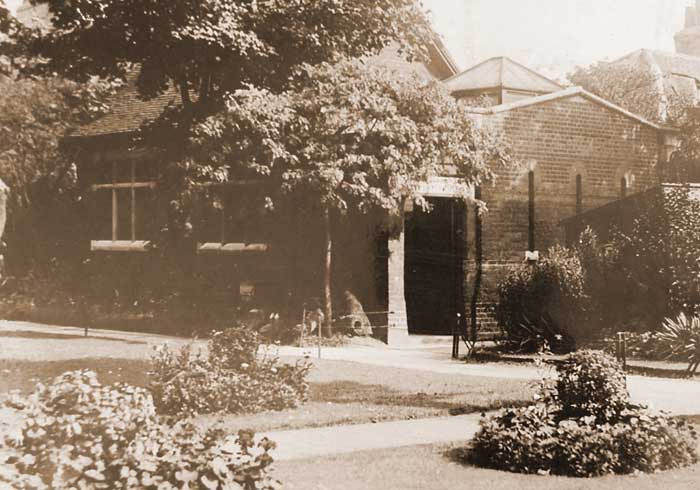
DISUSE AND DISREPAIR
The Nature Study Museum was closed during the Second World War; and, although this was only meant to be a temporary measure, it never reopened, and the disused building gradually fell into disrepair.
Although plans for a restoration and a re-opening have been muted from time to time, none of them have come to fruition, and the building becomes more and more ruinous with every passing year.
The day may well come when the decision is taken to demolish it, and, should that come to pass, then yet another location with a direct connection to the Jack the Ripper murders will become nothing more than a distant memory.
